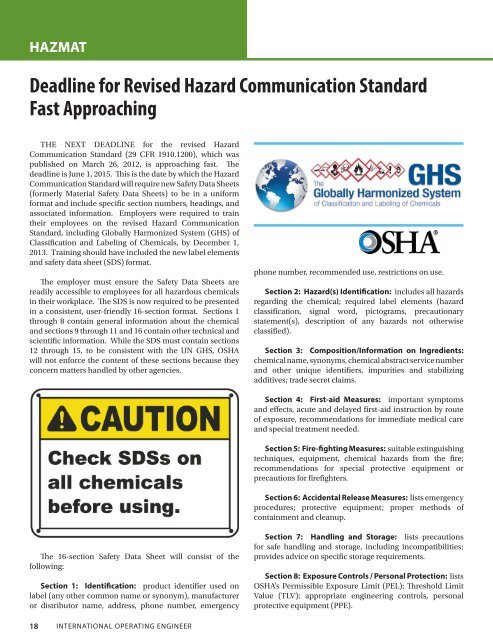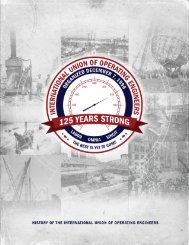Operating Engineer - Winter 2015
The quarterly magazine of the International Union of Operating Engineers.
The quarterly magazine of the International Union of Operating Engineers.
Create successful ePaper yourself
Turn your PDF publications into a flip-book with our unique Google optimized e-Paper software.
HAZMAT<br />
Deadline for Revised Hazard Communication Standard<br />
Fast Approaching<br />
THE NEXT DEADLINE for the revised Hazard<br />
Communication Standard (29 CFR 1910.1200), which was<br />
published on March 26, 2012, is approaching fast. The<br />
deadline is June 1, <strong>2015</strong>. This is the date by which the Hazard<br />
Communication Standard will require new Safety Data Sheets<br />
(formerly Material Safety Data Sheets) to be in a uniform<br />
format and include specific section numbers, headings, and<br />
associated information. Employers were required to train<br />
their employees on the revised Hazard Communication<br />
Standard, including Globally Harmonized System (GHS) of<br />
Classification and Labeling of Chemicals, by December 1,<br />
2013. Training should have included the new label elements<br />
and safety data sheet (SDS) format.<br />
The employer must ensure the Safety Data Sheets are<br />
readily accessible to employees for all hazardous chemicals<br />
in their workplace. The SDS is now required to be presented<br />
in a consistent, user-friendly 16-section format. Sections 1<br />
through 8 contain general information about the chemical<br />
and sections 9 through 11 and 16 contain other technical and<br />
scientific information. While the SDS must contain sections<br />
12 through 15, to be consistent with the UN GHS, OSHA<br />
will not enforce the content of these sections because they<br />
concern matters handled by other agencies.<br />
phone number, recommended use, restrictions on use.<br />
Section 2: Hazard(s) Identification: includes all hazards<br />
regarding the chemical; required label elements (hazard<br />
classification, signal word, pictograms, precautionary<br />
statement(s), description of any hazards not otherwise<br />
classified).<br />
Section 3: Composition/Information on Ingredients:<br />
chemical name, synonyms, chemical abstract service number<br />
and other unique identifiers, impurities and stabilizing<br />
additives; trade secret claims.<br />
Section 4: First-aid Measures: important symptoms<br />
and effects, acute and delayed first-aid instruction by route<br />
of exposure, recommendations for immediate medical care<br />
and special treatment needed.<br />
Section 5: Fire-fighting Measures: suitable extinguishing<br />
techniques, equipment, chemical hazards from the fire;<br />
recommendations for special protective equipment or<br />
precautions for firefighters.<br />
Section 6: Accidental Release Measures: lists emergency<br />
procedures; protective equipment; proper methods of<br />
containment and cleanup.<br />
The 16-section Safety Data Sheet will consist of the<br />
following:<br />
Section 1: Identification: product identifier used on<br />
label (any other common name or synonym), manufacturer<br />
or distributor name, address, phone number, emergency<br />
Section 7: Handling and Storage: lists precautions<br />
for safe handling and storage, including incompatibilities;<br />
provides advice on specific storage requirements.<br />
Section 8: Exposure Controls / Personal Protection: lists<br />
OSHA’s Permissible Exposure Limit (PEL); Threshold Limit<br />
Value (TLV); appropriate engineering controls, personal<br />
protective equipment (PPE).<br />
18 INTERNATIONAL OPERATING ENGINEER

















